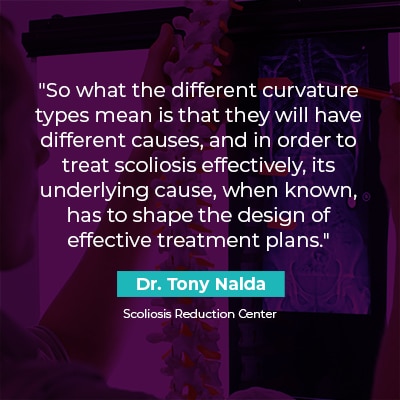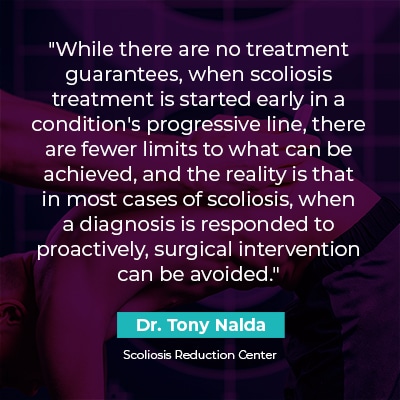The Main Scoliosis Curvature Types & What They Mean

Scoliosis involves the development of a side to side curvature of the spine with a rotational component that makes it a 3-dimensional condition. The rotation means scoliotic curves don't just bend unnaturally to the side, but also twist from front to back, back to front.
Scoliosis is a complex condition; it ranges widely in severity, affects all ages, can develop in any spinal section, and has different condition/curvature types. Typical cases of scoliosis involve right-bending curves, but atypical cases involve left-bending curves.
Part of diagnosing scoliosis involves comprehensively assessing conditions so they can be further classified based on key patient/condition variables, so let's start with how scoliosis is diagnosed and classified.
Table of Contents
Diagnosing and Classifying Scoliosis
The spine's natural and healthy curves are important; they help make the spine stronger, more flexible, and better able to handle mechanical stress incurred during movement, and when the spine develops an abnormal curvature, a lot of uneven forces are introduced to the body.
In order to reach a diagnosis of scoliosis, certain parameters have to be met.
There are a number of spinal conditions a person can develop that involve a loss of its healthy curves, but scoliosis has some unique characteristics that set it apart from the rest.
Scoliosis involves the development of an unnatural sideways spinal curvature in the sagittal plane, and the spine also rotates unnaturally.
In addition, a scoliotic curve has to be of a minimum size, and this is determined by a measurement known as Cobb angle which also classifies conditions based on severity:
- Mild scoliosis: Cobb angle measurement of between 10 and 25 degrees
- Moderate scoliosis: Cobb angle measurement of between 25 and 40 degrees
- Severe scoliosis: Cobb angle measurement of 40+ degrees
- Very-severe scoliosis: Cobb angle measurement of 80+ degrees
So the severity of a scoliotic curvature of the spine is a key factor that treatment plans are shaped around, and there are other curvature characteristics that inform the crafting of customized treatment plans; the complex nature of scoliosis necessitates a customized treatment approach.
Another important classification-point, and curvature characteristic, is its location within the spine.
Curvature Location
There are three main spinal sections: the cervical spine (neck), thoracic spine (middle/upper back), and the lumbar spine.
Scoliosis can develop in each of these main sections, but the thoracic spine, as the largest spinal section, is the most commonly affected by scoliosis: thoracic scoliosis.
So part of classifying scoliosis curvature types involves determining the most-affected spinal section as that's where treatment efforts will be concentrated, and in addition, curvature location can also indicate likely progressive rates and experienced symptoms.
In most spinal conditions, scoliosis included, the area of the body located closest to the affected spinal section is the most likely to feel the condition's direct effects.
In addition, scoliosis curvature types can also involve more than one spinal section as a combined scoliosis; for example, a thoracolumbar curve is a common type that develops in the lower thoracic spine and the upper lumbar spine and is diagnosed as thoracolumbar scoliosis.
Now that we have explored curvature location, let's move on to curvature type expressed by the direction of the unnatural spinal curve.
Curvature and Condition Type
Another important classification-point is condition type, and this involves determining curvature characteristics, one of which is the direction of unnatural spinal curves: right or left.
The most common type of scoliosis to affect both children and adult onset scoliosis is idiopathic scoliosis, and idiopathic means not clearly associated with a single-known cause, and the most prevalent form of scoliosis overall is adolescent idiopathic scoliosis, diagnosed between the ages of 10 and 18.
So what that means is that in the majority of cases, we don't fully understand why scoliosis develops; 80 percent of known diagnosed scoliosis cases are classified as idiopathic, and the remaining 20 percent are associated with known causes: neuromuscular scoliosis, degenerative scoliosis, and congenital scoliosis.
So cases of idiopathic scoliosis are considered typical, and in typical cases, the scoliotic curve bends to the right, away from the heart, and in atypical cases, the curve bends to the left, towards the heart.
Dextroscoliosis refers to scoliotic curves that bend to the right, and levoscoliosis refers to curves that bend to the left, towards the heart.
In addition, there are what's known as an S curve, or double curve, that involves the scoliotic curve bending in two directions, making it more complex to treat.
If an X-ray shows a patient's unnatural spinal curve bending to the left, this is a red flag for me that there is an underlying pathology at play, as in cases of neuromuscular scoliosis, congenital scoliosis, and degenerative scoliosis.
So curvature location and type factors into the different types of scoliosis.
A diagnosis of lumbar scoliosis, for example, would mean an unnatural sideways spinal curve has developed in the lumbar spine, and a further specification of lumbar levoscoliosis would mean that an unnatural left-bending scoliotic curvature of the spine has developed in the lumbar spine.
A diagnosis of lumbar dextroscoliosis would mean the lower back has developed a typical right-bending scoliotic curve, while a diagnosis of thoracic dextroscoliosis would mean that the thoracic spine has developed a typical right-bending scoliotic curve.
Condition Type and Treatment Options
 So what the different curvature types mean is that they will have different causes, and in order to treat scoliosis effectively, its underlying cause, when known, has to shape the design of effective treatment plans.
So what the different curvature types mean is that they will have different causes, and in order to treat scoliosis effectively, its underlying cause, when known, has to shape the design of effective treatment plans.
For example, in atypical scoliosis cases, such as in neuromuscular scoliosis, underlying neuromuscular conditions have caused the scoliosis to develop as a secondary complication, so as the neuromuscular scoliosis is a symptom of a larger medical condition, the neuromuscular conditions have to be the focus of treatment.
While there are a number of neuromuscular conditions that can cause scoliosis, among the most common are cerebral palsy, spina bifida, and muscular dystrophy.
In cases of congenital scoliosis, these are caused by vertebral abnormalities that developed as the spine was forming in utero; affecting approximately 1 in 10,000, congenital scoliosis is a rare atypical form, and to address the challenges of treating scoliosis in such young patients, treatment plans have to be modified and adjusted accordingly.
Degenerative scoliosis occurs in adults over the age of 50 and after idiopathic scoliosis is the most common type of adult onset scoliosis, and this type is caused by the spine experiencing natural age-related degenerative changes.
Now that we have defined the condition, explored how it's diagnosed and classified, and what the different curvature types mean, let's now address some common condition effects, as knowing the early signs of scoliosis can help lead to early detection and intervention.
Common Symptoms of Scoliosis
As the vertebrae of the spine become unnaturally tilted, this is exposing the spine and its surrounding muscles, nerves, and the entire body, to uneven forces.
While the main symptom in adult scoliosis patients is pain, the main symptom of scoliosis in children involves postural changes caused by the condition's uneven forces disrupting the body's overall symmetry.
While each case is unique, oftentimes the earliest condition indicators are uneven shoulders, shoulder blades, and uneven hips.
In addition, the development of a rib arch, arms and legs that appear to hang at different lengths, and changes to gait, balance, coordination, and ill-fitting clothing can also indicate the need for further testing.
 While there are no treatment guarantees, when scoliosis treatment is started early in a condition's progressive line, there are fewer limits to what can be achieved, and the reality is that in most cases of scoliosis, when a diagnosis is responded to proactively, surgical intervention can be avoided.
While there are no treatment guarantees, when scoliosis treatment is started early in a condition's progressive line, there are fewer limits to what can be achieved, and the reality is that in most cases of scoliosis, when a diagnosis is responded to proactively, surgical intervention can be avoided.
Surgical treatment has its place, but it is a costly, invasive, and risky spinal fusion surgery.
Conclusion
When the spine curves unnaturally, this type of spinal deformity needs to be taken seriously, particularly as progressive conditions like scoliosis have it in their nature to get worse over time, making them more difficult to treat.
What the different curvature types tell me is how best to craft and customize effective treatment plans; the more details I know about my patients who develop scoliosis, and the more information I have about their curvature type, the more specific I can get with treatment.
The vertebrae of the spine can be responsive to condition-specific chiropractic care, which is why here at the Scoliosis Reduction Center, I treat patients with a conservative chiropractic-centered treatment approach with proven results.
Regardless of curvature type and severity, the best time to start scoliosis treatment is always now, immediately following a scoliosis diagnosis; waiting only puts patients at a higher risk of needing invasive surgical treatment in the future.
Dr. Tony Nalda
DOCTOR OF CHIROPRACTIC
After receiving an undergraduate degree in psychology and his Doctorate of Chiropractic from Life University, Dr. Nalda settled in Celebration, Florida and proceeded to build one of Central Florida’s most successful chiropractic clinics.
His experience with patients suffering from scoliosis, and the confusion and frustration they faced, led him to seek a specialty in scoliosis care. In 2006 he completed his Intensive Care Certification from CLEAR Institute, a leading scoliosis educational and certification center.
About Dr. Tony Nalda
 Ready to explore scoliosis treatment? Contact Us Now
Ready to explore scoliosis treatment? Contact Us Now





